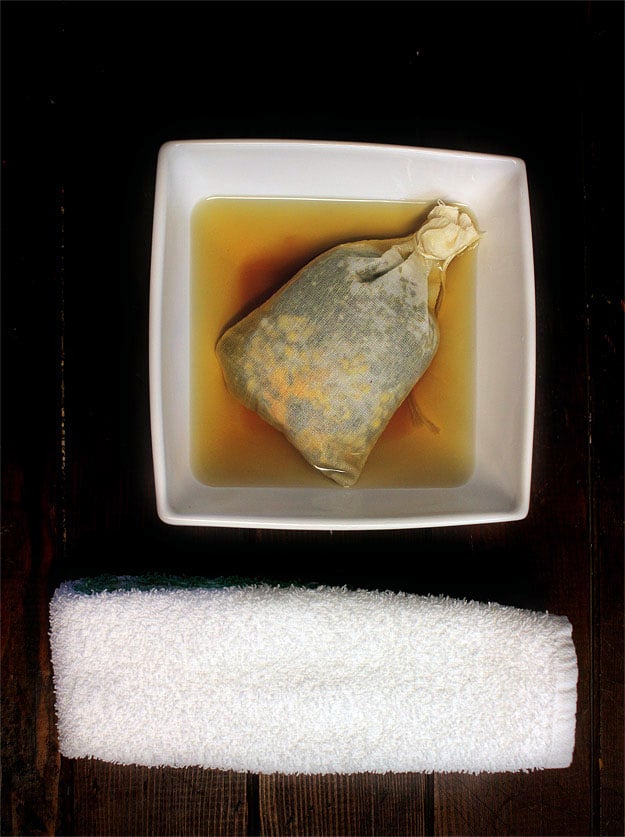Below you will find a variety of products that can be made by medicinal herbs. I have also included definitions of what each product discussed is for clarity.
Tincture: A tincture is a medicinal preparation made by soaking a plant in alcohol for a period of time to extract the healing components from a medicinal herb. This mixture of herbal parts and alcohol will need to sit for weeks up to months depending on the strength of your tincture that you want and the type of herb/part of the herb that is being used.

Decoction: A decoction is essentially a simmered style of tea making. Decoctions typically use bark, roots, mushrooms, and seeds to be made, typically brewed in a stainless steel or stovetop-safe glass pot. The herb is placed in water, brought to a boil, and then simmered with a lid on for 20 minutes to a half hour. The decoction is then taken off the heat and strained. (Chestnut).

Salve: A salve is made when an herb sits in an oil for a long enough time for its medicinal properties to soak into, or infuse, the oil. To prepare, herbs are soaked in food grade oil for weeks up to months. This allows certain phytochemicals to be extracted into the oil (Bhattacharya).

Infusion: When making an infusion, the lightweight parts of an herb are typically used, such as leaves, flowers, and fruits. To prepare, boiling water is poured over the herb, then it sits covered for twenty minutes before it is strained. The infusion can be drunk immediately or cooled to room temperature and refrigerated (Chestnut).

Poultice: “A therapeutic topical application of a soft, moist mass of plant material (bruised fresh herbs), usually wrapped in a fine woven cloth and applied to the affected area” (Terminology).

Herbal Compress- “soaking a clean soft cloth in a strained, strong herbal infusion or decoction, used warm or cold, held in place onto the affected area to alleviate pain or reduce inflammation” (Terminology).

Cooling Herbal Compress: Various Herbs can be used to make this. Link – https://blog.mountainroseherbs.com/cooling-herbal-compress-3-easy-steps
Ingredients:
- Herb of your choice for a tea to be made. An example would be Dandelion.
- Water
- Cotton muslin bag or cheesecloth or saucepan or teapot
Instructions:
- First, make a strong tea with desired herbs. The recommended ratio of herb to water is 3 tablespoons to one cup of water.
- Use a muslin bag and a bowl to steep the tea. – This can also be done by steeping the tea in a saucepan or teapot.
- Soak a clean piece of fabric/cloth material in the tea and squeeze excess tea out of the cloth.
- Let the cloth cool, it can be placed in the refrigerator for faster cooling.
- Place soaked cloth on your skin and wrap around the area in need. Let sit on the area for a cooling effect.
Goldenrod Essential Oil Link – https://thenerdyfarmwife.com/foraging-using-goldenrod/
Ingredients:
- Dried Goldenrod flowers
- Oil (sunflower, sweet almond, or olive)
- Jar- any size you would like – jar will need to be filled 1/4 to 1/2 full with dried flowers
Instructions:
Slow Way – Cap the jar and tuck it into a dark cabinet for 4 to 6 weeks then strain
Solar Way – Don’t cap the jar, but cover it with a piece of cheesecloth or scrap of an old t-shirt instead. Set the jar in a sunny window for several days or a few weeks. The heat from the sun will help the oil infuse faster
Speedy Way- Don’t cover the jar, set it down into a small saucepan containing a few inches of water. Set the pan over a low burner and hear for around 2 to 3 hours, watching the oil carefully. You can strain the oil and use it right away or let the oil continue infusion for another few days.
Echinacea Poultice Link – https://www.echinacea.net/how-is-echinacea-grown-used/make-your-own-echinacea-poultice
Ingredients:
- 1/4 cup fresh echinacea root
- fresh chickweed, plantain, or comfrey leaves (these are other medicinal herbs)
Instructions:
- Grind herbs together
- If you need to, add a little warm water to make a pasta
- Place a small dollop of the paste on the wounds and cover with a clean dressing
- Change dressings as needed.
Turkey Tail Mushroom Decoction: Link – http://www.handmadeapothecary.co.uk/blog/2017/2/2/medicinal-mushrooms-turkey-tail
Instructions:
- Chop or break up the fresh or dried mushroom into small pieces (this increases surface area and gets ‘more out’ of them.
- Place about 1 tablespoon in a saucepan and cover with two cups of water and a lid.
- Bring to the boil and simmer gently for 20-30 minutes. You can do longer – up to an hour but you may need to top up the water as it evaporates.
Turkey Tail Tincture: Link – http://www.handmadeapothecary.co.uk/blog/2017/2/2/medicinal-mushrooms-turkey-tail
Instructions:
- Chop or break up fresh or dried mushrooms into small pieces
- Cover with vodka.
- Label with what it is. – Turkey Tail Mushroom Tincture.
- Leave in a cool dark place for at least 1 month (you can leave it longer).
- Strain, bottle, and label.
Chickweed Salve:
Yield: Approximately 12-14 tubes of lip balm.
Ingredients:
- 1-ounce herbal infused sunflower oil
- ½ ounce castor oil
- ½ ounce beeswax (for a vegan option substitute ¼ ounce candelilla wax*)
- Essential oil (optional)* Derived from the leaves of the small Candelilla shrub, this wax is a plant-based alternative to beeswax.
- The desired amount of herbs. You will need at least 2 cups fresh herbs, Chickweed, and Comfrey are two examples given above to add to your oil. Comfrey is an herb also known for its ability to heal wounds and burns.
Instructions:
- Melt the oils and the wax over medium-low heat in a double boiler.
- Stir slowly.
- Once combined, remove from heat and add essential oils, infusing them.
- Pour into lip balm tubes or small tins, and let cool until firm (several hours).
- Store out of direct sunlight.
